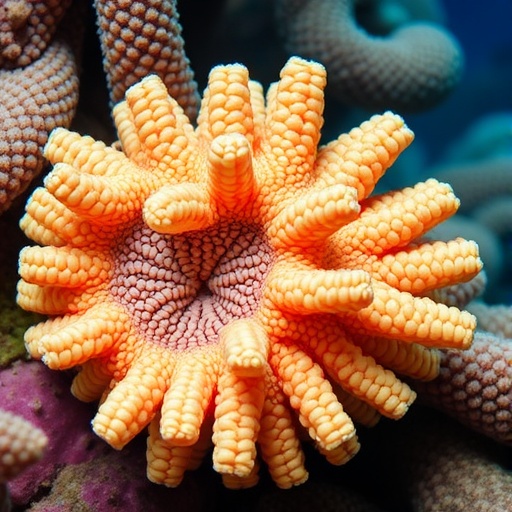In the vast and intricate ecosystems of coral reefs, a hidden danger lurks, posing threats not just to the colorful corals themselves but to entire marine environments. Recent research spearheaded by Liu, PY., Chiu, WC., Lim, S.L., and their collaborators has shed light on the mysterious and pervasive sponge known as Terpios hoshinota. This sponge, infamous for its destruction of coral reefs, exhibits a remarkable ability to thrive under extreme environmental stressors, raising crucial questions about the future of coral ecosystems worldwide.
The study culminated from a comprehensive genomic analysis that aimed to unravel the underlying mechanisms behind the resilience and adaptability of T. hoshinota. As climate change continues to push marine environments to their limits, understanding how this sponge flourishes in conditions that would otherwise be detrimental to many marine organisms is not just interesting—it’s essential.
The research focuses on the genetic underpinnings that allow T. hoshinota to prosper in the face of rising sea temperatures, ocean acidification, and various pollutants. It is now well established that climate change has dire implications for marine biodiversity. The stressors these ecosystems endure can catalyze shifts that drastically alter their composition. As corals struggle, T. hoshinota capitalizes, spreading across coral reefs and frequently leading to mass coral die-offs.
One of the surprising findings of the research was that T. hoshinota possesses a unique set of genes that facilitate the breakdown of harmful substances in its environment. These genes effectively enable the sponge to withstand conditions that would typically weaken or kill other marine organisms. The genomic data indicates that this sponge has evolved sophisticated biochemical pathways, granting it a metabolic edge in nutrient acquisition even when resources are scarce.
Perhaps more alarming is the sponge’s ability to adapt rapidly to changing environmental conditions. The study highlights the sponge’s remarkable genomic plasticity, allowing for quick responses to stress. While many coral species take years or decades to make adaptations, T. hoshinota seems to have a genetic toolkit that allows for swift modifications. This adaptability could mean that the sponge will remain a dominant presence within marine ecosystems, further complicating conservation efforts targeting coral health.
As the researchers delved deeper into the genome of T. hoshinota, they uncovered multiple gene families associated with stress response, cell signaling, and metabolism. These genes appear to contribute not only to the sponge’s survival in extreme conditions but also to its ability to outcompete corals and other marine organisms for space and resources. The ecological implications of this phenomenon could be catastrophic if left unaddressed, as it suggests a shift in competitive dynamics within coral reef environments.
However, it’s important to note that the adaptability of T. hoshinota could lead to unintended consequences. While this sponge thrives, the implications for biodiversity loss are profound. As it claims territory, the corals that provide structure and habitat for countless marine species may succumb to its encroachment. The study posits that the presence of T. hoshinota could alter the fundamental structure of reef communities, disrupting ecosystems that have thrived for thousands of years.
Moreover, the research underscores the urgent need for long-term monitoring of coral reef ecosystems in the face of climate change. Investigating the adaptive mechanisms of invasive species like T. hoshinota will be crucial for developing effective conservation strategies. The researchers advocate for a multipronged approach that combines genomic studies with ecological monitoring to better predict potential shifts in coral reef communities and design interventions that can mitigate the impacts of such invasive species.
Policy implications are also at the forefront of this research. As marine ecosystems become increasingly threatened by climate change and human activity, understanding the role of organisms like T. hoshinota is essential for formulating effective marine management policies. Stakeholders, conservationists, and regulators must prioritize research and mitigation strategies that address the challenges posed by adaptable invasive species to protect the intricate balance of marine environments.
Potentially, the research into T. hoshinota could foster a broader dialogue on how to address the challenges posed by invasive species in marine ecosystems. Awareness campaigns aimed at highlighting the profound impacts of climate change on marine biodiversity could garner support for conservation initiatives. The findings serve as a clarion call for accelerated efforts in marine conservation, emphasizing the need for all stakeholders to recognize the interconnectedness of ecosystems and the cascading effects that arise from the survival of species like T. hoshinota.
In conclusion, the research led by Liu, PY., Chiu, WC., and Lim, S.L. marks a vital step in understanding how invasive species can adapt and thrive under increasing environmental pressures. The genomic insights shed light on the ecological dynamics surrounding T. hoshinota and its capacity to threaten coral reefs. As the world grapples with the challenges of climate change, studies of this nature will be critical to inform conservation strategies and ensure the survival of coral reefs in the face of adversity.
The complex interplay between T. hoshinota and coral ecosystems is only just beginning to emerge through this groundbreaking research. Future studies will undoubtedly expand our understanding of the genetic adaptations that allow this sponge to survive and thrive, providing a framework for addressing one of the most pressing challenges faced by marine conservationists today.
As we dive deeper into the genomic intricacies of Terpios hoshinota, the urgency of the situation becomes clearer. With every rise in temperature and every increment of pollution, the impacts on coral reef health become more pronounced. Ultimately, this research serves not just to inform but to compel action—action founded on understanding the future of coral ecosystems, their vulnerabilities, and the species that threaten their existence.
Subject of Research: Adaptability of Terpios hoshinota under environmental stress
Article Title: Genomic analysis reveals broad adaptability of coral-killing sponge (Terpios hoshinota) under environmental stress
Article References:
Liu, PY., Chiu, WC., Lim, S.L. et al. Genomic analysis reveals broad adaptability of coral-killing sponge (Terpios hoshinota) under environmental stress. BMC Genomics 26, 830 (2025). https://doi.org/10.1186/s12864-025-11962-7
Image Credits: AI Generated
DOI: 10.1186/s12864-025-11962-7
Keywords: Coral reefs, Invasive species, Terpios hoshinota, Climate change, Genomic analysis, Marine biodiversity.




